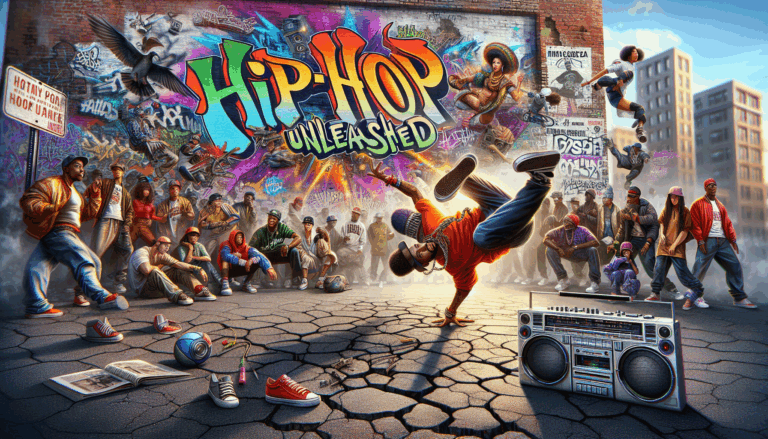The Pulse of the Streets: Hip-Hop’s Roaring Genesis
Step into the heart of the South Bronx in the 1970s—a turbulent, electrifying time when block parties roared louder than the city’s subway trains. Hip-hop, an American music revolution, was born not from flashy studios but from cracked sidewalks and boomboxes blasting under flickering streetlights. This was the birthplace of a cultural tsunami—a genre that fused rhythm, poetry, and raw storytelling into a sonic force like no other.
Emerging from the ashes of urban decay and social strife, hip-hop was more than music; it was a lifeline. DJs like Kool Herc, whose immortal “Merry-Go-Round” technique spun breakbeats like a magician weaving spells, laid the foundations. Herc’s ability to isolate and extend the most danceable sections of records gave birth to breakdancing and the MC’s role as a charismatic storyteller. The historical context entwines deeply with the civil rights movement, economic hardship, and the yearning for identity among African-American and Latino youths. Hip-hop wasn’t merely a genre—it was a voice for the voiceless.
Decoding the Zen of Hip-Hop
To the untrained ear, hip-hop might sound like beats and raps—but delve deeper, and you’ll uncover a symbiotic blend of four pillars: MCing (rapping), DJing, breakdancing, and graffiti art. Each element contributes to a communal tapestry that speaks of resistance, celebration, and evolution.

Musically, hip-hop thrives on rhythm-driven beats—a pulse that mirrors a heartbeat in sync with urban life. Sampled vinyl loops, syncopated drum breaks, and synthesized basslines create a hypnotic backdrop over which MCs spit rhymes that range from playful braggadocio to poignant social commentary. Lyrically, it’s a lyrical chess game—intricate wordplay, metaphors, storytelling, and social critiques rolled into verses that demand attention and respect.
Hip-hop’s elasticity has allowed it to infuse strands from jazz, funk, soul, and even rock, making it one of the most versatile and globally influential genres. Unlike the regimented structures of many music styles, hip-hop’s freeform flow embodies chaos and order simultaneously, reflecting life itself.
The Titans of Hip-Hop: Architects of an Empire
No hip-hop odyssey is complete without tipping the hat to its iconic architects. Grandmaster Flash, a pioneering DJ, elevated turntablism with techniques like scratching and backspinning, turning the turntable into a live instrument. His group, Grandmaster Flash and the Furious Five, delivered “The Message,” a groundbreaking track that poignantly boxed social issues within a captivating groove. “It’s like a jungle sometimes, it makes me wonder how I keep from going under”—these words rattled through speakers, spotlighting urban despair and resonating with millions.
Run-D.M.C. revolutionized hip-hop in the ‘80s by blending rock elements with rap and bringing street style to mainstream culture. Their fierce edge opened doors previously slammed shut by skeptics. Public Enemy followed, layering dense, politically charged lyrics with bombastic production from the Bomb Squad, turning hip-hop into a powerful tool for activism.
The ‘90s gave rise to lyrical geniuses like Tupac Shakur and The Notorious B.I.G., whose storytelling and charismatic personas elevated hip-hop’s artistry to Shakespearean heights. Their tragic, high-profile deaths underscored hip-hop’s volatile life but left behind potent legacies.
Anthems and Albums That Shaped a Movement
Dive into hip-hop’s playlist, and you encounter sonic icons that shaped not just music but culture itself. “Rapper’s Delight” by The Sugarhill Gang catalyzed hip-hop’s commercial breakthrough in 1979—a catchy, party-starting track that proved this street-born sound was here to stay.
Public Enemy’s “Fight the Power” became an anthem for defiance and black empowerment, a rallying cry against systemic oppression layered over thunderous beats. Nas’ “Illmatic” (1994) remains an artistic masterpiece, pairing vivid narratives with jazzy production, encapsulating hip-hop’s capacity for profound storytelling.
OutKast’s “Aquemini” blended Southern charm with experimental beats, widening hip-hop’s geographical and sonic boundaries. The genre’s evolution continued with Jay-Z’s “The Blueprint,” Kanye West’s “The College Dropout,” and Kendrick Lamar’s “To Pimp a Butterfly,” each album etching new chapters in hip-hop’s ever-unfolding saga.
Hip-Hop’s Everlasting Echo in the Cultural Soundscape
Hip-hop’s influence stretches far beyond turntables and rap battles; it has reshaped language, fashion, dance, and global identity. Phrases birthed in rhymes permeate everyday speech. Baggy pants, sneakers, and bling ascend from streetwear to haute couture runways, blurring the lines between counterculture and mainstream.
Hip-hop also pushed the boundaries of American music, fusing with EDM and dance music elements to birth new hybrid sounds that dominate festivals and clubs worldwide. The genre’s collaborative spirit fuels endless innovation, where a rapper’s cadence can ride atop electronic drops or dance beats, creating fresh, thrilling experiences.
Moreover, hip-hop’s storytelling ethos ignited narrative transformations in media and literature—ushering in voices historically marginalized. The genre’s roots in social activism remain potent, inspiring movements and raising awareness on racial injustice, poverty, and identity.
As a club DJ myself, spinning hip-hop alongside EDM and dance music, I witness firsthand how these rhythms unite crowds, telling stories through movement and sound. Hip-hop’s dynamic energy is a living testament to creativity’s power to transcend adversity, telling us—beat by beat, rhyme by rhyme—that our stories matter.
In the grand symphony of American music, hip-hop is a relentless heartbeat, a defiant, joyous, and profoundly human expression forever changing the rhythm of our collective soul.